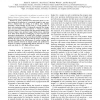1806 search results - page 96 / 362 » Randomness and halting probabilities |
PODS
2006
ACM
14 years 9 months ago
2006
ACM
The link structure of the Web can be viewed as a massive graph. The preferential attachment model and its variants are well-known random graph models that help explain the evoluti...
ACCV
2009
Springer
14 years 3 months ago
2009
Springer
Abstract. In this paper, we propose an efficient method for finding consistent correspondences between two sets of features. Our matching algorithm augments the discriminative pow...
ICB
2009
Springer
14 years 3 months ago
2009
Springer
In this paper, a Bayesian method for face recognition is proposed based on Markov Random Fields (MRF) modeling. Constraints on image features as well as contextual relationships be...
KBSE
2008
IEEE
14 years 3 months ago
2008
IEEE
Abstract—A poorly understood but important factor in random testing is the selection of a maximum length for test runs. Given a limited time for testing, it is seldom clear wheth...
SIGECOM
2006
ACM
14 years 2 months ago
2006
ACM
Braess’s Paradox is the counterintuitive but well-known fact that removing edges from a network with “selfish routing” can decrease the latency incurred by traffic in an eq...

